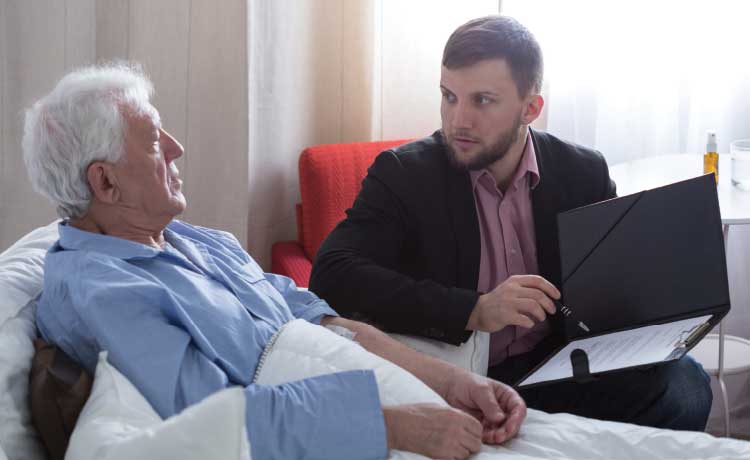Who Is the Patient Advocate?
By Megan Headley
If you think medical school is challenging, try navigating the labyrinth of medical challenges that chronic patients face. Sorting out payment, deciding among specialists, understanding differing second opinions—all of these and more can be major hurdles for patients already overwhelmed by a diagnosis. The issues are compounded by adding in age and conditions such as dementia, which deepen the cloud of confusion around care complexities. Physicians see the effects when confused patients stop taking their medications or overwhelmed individuals don’t schedule necessary follow-up exams, leading to a deterioration in condition or higher use of emergency services.

A fast-growing solution is the rise of private patient advocates. The Institute for Healthcare Improvement defines a patient advocate as a “supporter, believer, sponsor, promoter, campaigner, backer, or spokesperson.” This can be a family member or close friend, but it’s increasingly an independent professional who specializes in helping patients and families make sense of their healthcare options.
In fact, the Patient Advocate Certification Board’s multiyear effort to develop board certification paid off in March 2018 when it held its first test, certifying approximately 150 patient advocates.
“The patient advocacy movement is growing,” says Debby Deutsch, founder and principal advocate of Patient Care Partners LLC in Madison, Wisconsin, and among the first round of Board Certified Patient Advocates (BCPS). As Deutsch adds, “There is such a need for this.”
Empowered patients report higher satisfaction with care teams
Private patient advocates first and foremost serve patients, but they also see themselves as partners in the healthcare team. They share clinicians’ goals of doing what’s right for the patient, but they have the added benefits of time and a holistic view of an individual’s health—things that are available to too few physicians today.
“The biggest benefit is enhanced patient-provider communication, which also enhances patient safety and clinical outcomes,” explains Jessica Tulloss, MPH, RN, CPPS, CLNC, owner and patient advocate for TrueCourse Healthcare Consulting LLC in Roswell, Georgia.
“Offering this type of individualized support has a way of helping the efficiency of the healthcare system,” Deutsch says. “And it increases my clients’ levels of satisfaction with their healthcare.”
When patient advocates help their clients work through healthcare challenges, they find patients become more engaged in their care and more satisfied with their providers. Patients also typically become more compliant with medication and follow-up appointments.
Take, for example, a client of Kim Mcilnay, a former physician who now owns Together Patient Advocates LLC in Sacramento, California. “The client was supposed to start a medication that he would take once a week and then a supplement that he needed to take daily to help the medication,” Mcilnay says. “When we finished the appointment and I asked the client to share back what he understood, he understood he was supposed to take the medication every day.”
“Advocates can also help to ensure patients understand the plan of care, follow through on the plan of care, and ask questions if needed,” Tulloss elaborates. “This is especially important after appointments and discharges. Depending on the situation, the client may not be in a state of mind to process all the information that’s been given to them, let alone think of the right questions to ask. While nurses and doctors can provide instructions and orders, if a patient does not follow through because they missed something or misunderstood, it can affect the desired outcome, to the point of even an adverse outcome.”
Creating a full healthcare picture
A private patient advocate can also help organize information to present a full picture to physicians.
“Providers depend on the patient’s ability to provide complete and accurate information regarding their medications and health history. Some patients see multiple providers over the course of several years. Private advocates can be instrumental in assisting clients to gather and organize key information and have it readily available for providers,” Tulloss says.
During her time as a resident, Mcilnay recalls, she began asking a patient with multiple issues to write problems out prior to her appointment. “Her number one issue was her toenail fungus, and her 20th issue was her chest pain,” Mcilnay says. “By having that written in a list, we could each pick our most important issues, and she picked the toenail fungus and I picked chest pain. We would have never gotten to chest pain if she had been going down her list in order.”
More challenging are patients who can’t speak to their own struggles, such as those suffering from dementia.
“A lot of times patients get confused by the questions,” Mcilnay says. “So I’ve got that whole picture in my mind. For example, I went to an appointment with a patient and the neurologist asked if he was having any difficulty with urinary incontinence. The patient’s response was no because it wasn’t a problem for him—he wears diapers and it was okay. Yet the disease that the clinician was looking for causes dementia and urinary incontinence. This client was having some cognitive difficulties, so the clinician wouldn’t have known to look further for that condition without knowing that he was actually having the incontinence.”
In each of these instances, patient advocates become a channel for improving communication. And as Teri Dreher, RN, CCRN, iRNPA, owner and founder of NShore Patient Advocates in Chicago, points out, “Really, medical error is due in large part to miscommunication.”

What you can expect from a private patient advocate
Many patient advocates come from the medical community and have backgrounds as RNs or physicians. They’re well aware of the time constraints present in the healthcare system and strive to balance patient needs with the limitations physicians face.
“I coach my clients on the fact that the practitioners we’re going to see are ordered by the system to move patients through,” Deutsch says. “I brace them for the fact that the national standard is eight to 15 minutes for a patient visit. We have to prepare for the fact that we’re likely only going to be seen for 10 to 15 minutes and oh, by the way, while we’re there the physician will be documenting and on the computer; there’s a lot going on during that time. So I make sure we’re very well-organized, we’ve got the questions all mapped out, and I’ve got the patient prepped.”
Tulloss counsels preparing practitioners for the patient advocate’s arrival ahead of time. “To avoid potential challenges, I always recommend clients inform their providers early on of their intent to work with a private advocate,” she says. “I also make sure that if I’m attending appointments or hospital visits, either myself or the client informs the healthcare team beforehand. HIPAA forms are submitted in advance, and I keep a copy on hand. This helps to ensure there are no surprises.”
Mcilnay works closely with clients before an appointment to outline and prepare any questions they might have, as well as assemble a high-level view of the client’s issues. “I usually do a summary sheet before the appointment that lists our issues, and if it’s a client with multiple issues, usually there’s an acknowledgment that we realize there may not be time to address all of these different problems,” she says.
For patients with complex medical needs, Mcilnay may give a copy of the summary to the medical assistant, who will give it to the clinician to look at while the patient is being checked in. “My goal there is that they can scan over it and make sure there aren’t issues that they feel are higher-priority,” she says.
During the appointment, Deutsch finds that the simple act of notetaking can add a level of accountability that gives more detail to the process. “I take notes the whole time, making sure the questions are answered and understood,” she explains.
While patient advocates work to ensure their patients feel understood, many are also able to fall back on their professional background to better address physicians’ first concerns.
“I was a critical care nurse. I know what doctors want to hear first, second, and third. Patients want to go into a story and physicians stop listening,” points out Barbara Abruzzo, founder and president of Livingwell Health Advisory in New York.
“If there’s a patient advocate on board, [physicians] can communicate much more efficiently with a colleague rather than listening to a family member talk for 45 minutes,” Dreher agrees. “We can come in, hand you a two-page professionally prepared medical profile or care plan that says who this patient is, what happened today, what we’re concerned about, etc. If you have a professional that knows how doctors think and knows what information they need, you just cut down on the amount of time that they have to spend, and then they can quickly, accurately diagnose the patient to get them treated instead of standing around scratching their heads because the patient’s too sick to give an accurate history.”
Your relationship with the patient advocate
Given the newness of the patient advocate accreditation program offered by the Patient Advocacy Certification Board, it’s easy to appreciate why many professionals in the field are relatively new to their role—and why many physicians might be confused about what this role entails.
“Once they understand we’re not there for any legal reasons, they really calm down,” Dreher finds. “We don’t really get involved with any kind of legal things. Rarely will we see something that just isn’t quite right in the hospital, and then we’ll go straight to the hospital management department or a supervisor and try to sort it out so it doesn’t lead to something worse. We actually help prevent medical error and lawsuits.”
If you haven’t worked with a private patient advocate yet, it’s becoming more likely you will. The Patient Advocacy Certification Board held its second test in September, with double the number of individuals sitting for the BCPS certification. And as physicians begin working with patient advocates, many are encouraging other patients to seek out these problem solvers.
“I have had clinicians ask if they can refer clients to me,” Mcilnay says. “They’re definitely seeing a benefit to my clients in having me there.”
Megan Headley is a freelance writer and owner of ClearStory Publications. She has covered healthcare safety and operations for numerous publications. Headley can be reached at megan@clearstorypublications.com.
